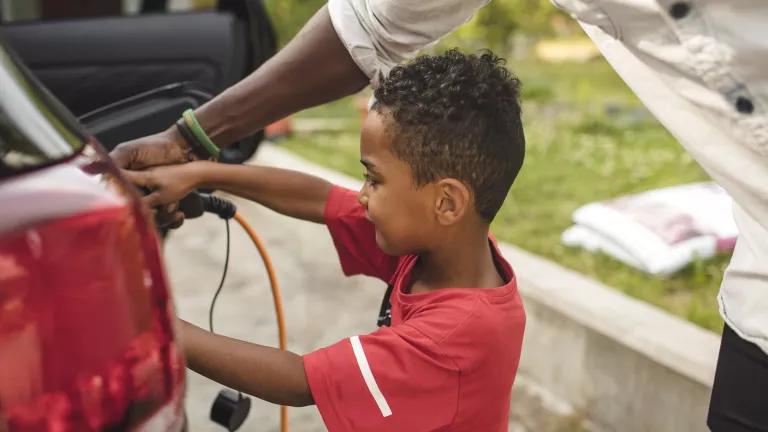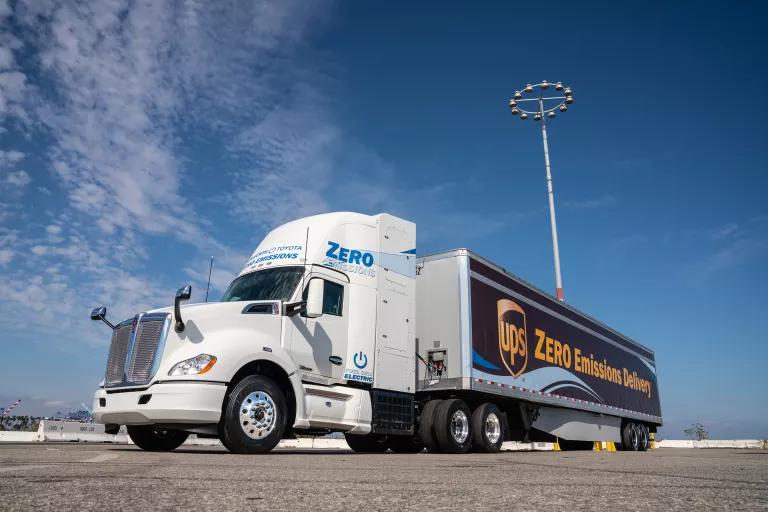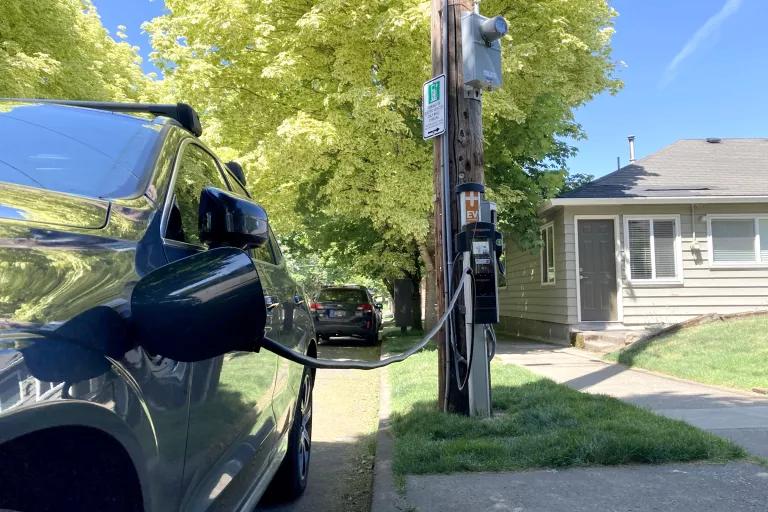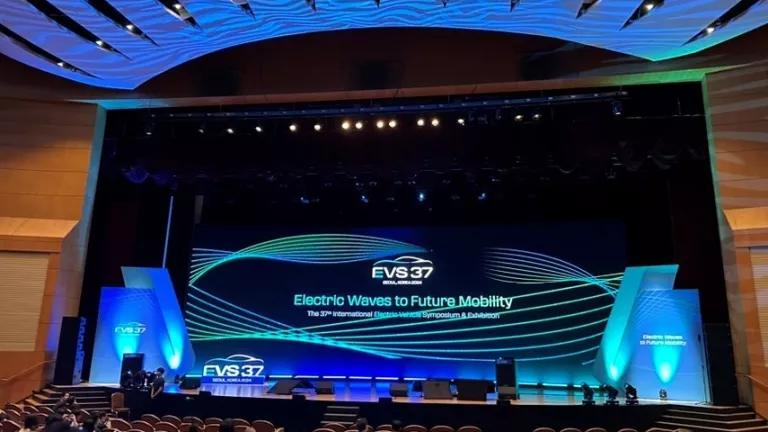Accelerating Progress on Clean Vehicles
A zero-pollution electric vehicle future is absolutely feasible. But 2022 is no time to rest.

Part of NRDC’s Year-End Series Reviewing 2021 Climate & Clean Energy Developments
The United States is getting back on the road to cleaning up transportation pollution. This year, multiple states enacted strong pollution standards for cars and freight trucks, helping to accelerate the shift to pollution-free electric vehicles (EVs). Investments in plugs to charge electric vehicles also grew across the country. And, in a fitting cap to 2021, the Biden administration just finalized standards for new passenger cars that will allow all Americans to drive cleaner, more affordable vehicles.
This progress is certainly needed since transportation is the biggest source of climate pollution and a major contributor to the smog and soot that threaten our health. The recent hike in gasoline prices—just as many of us are traveling for the holidays—is also a painful reminder of our dangerous dependence on oil. Strong policies that make vehicles cleaner and more efficient while also expanding charging infrastructure are essential to a safer, healthier future.
Let’s look at some key milestones for 2021, and what’s ahead for next year.
U.S. EPA Tightens Clean Car Standards
On President Biden’s first day in office, he directed the Environmental Protection Agency (EPA) to revisit the Trump administration’s unjustified and harmful weakening of car standards. On December 20, EPA issued new rules that significantly tighten greenhouse gas emissions levels for new cars, SUVs, and pickup trucks sold in model years 2023 through 2026. Vehicles meeting the standards will be cleaner due to advanced, fuel-efficient engines and high-speed transmissions or electric power trains.
All told, these standards will cut carbon emissions by 3.1 billion metric tons by 2050, equivalent to two full years of emissions from all on-road vehicles in the United States.
The standards are based on performance, not technology. EPA sets emissions levels for vehicles based on their size, and automakers can choose what technologies to deploy on each vehicle, as long as average tailpipe emissions across the manufacturer’s fleet decline over time. For model year 2026, the standards are set at 161 greenhouse gas (GHG) grams per mile (specified in carbon dioxide equivalents). That’s a 28 percent reduction from the model year 2021 standard of 223 GHG grams per mile.
These cleaner vehicles have the important benefit of needing less gasoline to operate. According to EPA’s analysis, the average new 2026 vehicle will deliver net savings of $1,083 to consumers, as lower fuel costs more than offset the cost of the clean vehicle technologies.
When EPA initially proposed the standards in August 2021, they weren’t as strong. NRDC, our supporters, and our allies pushed the agency to make improvements in line with available technology and the urgent need to cut the pollution threatening our climate and health. The finalized rule is significantly better due to tighter standards in 2025 and 2026 and the phaseout of unnecessary regulatory incentives.
EPA now projects that 17 percent of new auto sales will be zero-emission electric vehicles in 2026, which is more than double the projection under the agency’s initial proposal and more than four times the current EV sales. Importantly, EPA’s emissions standards signal to the auto industry that the drive to zero emissions is underway. President Biden has already directed EPA to begin work on standards that extend through at least 2030, and there’s no reason why at least 50 percent of sales shouldn’t be zero emissions by then.
States Blaze the Path to Zero-Emission Vehicles
California and other states are already working toward a full zero-emission car fleet. Throughout 2021, the California Air Resources Board has been developing passenger vehicle emissions standards for model year 2027 and requiring 100 percent of new sales to be zero-emission electric vehicles by 2035. Those regulations will be formally proposed and potentially finalized in 2022. The rules comprise California’s Advanced Clean Cars II (ACC II) program, an extension of its existing ACC I standards.
In 2021, Minnesota and Nevada became the most recent states to adopt California’s existing ACC I rules, resulting in a total of 16 states that represent 37 percent of the U.S. car market. Virginia is also in the process of adopting ACC I. These states stand poised to adopt California’s upcoming ACC II rules and bolster the case for federal standards that would achieve the same 100 percent zero-emission car sales target in 2035.

One of ten new zero-emissions trucks developed through a collaboration between Kenworth and Toyota to move cargo from the Port of Los Angeles.
Freight trucks must also get cleaned up and rapidly transition to zero emissions if we are going to solve transportation’s pollution problem. Medium- and heavy-duty trucks make up 24 percent of transportation carbon pollution; when combined with cars, on-road vehicles contribute more than 80 percent of the sector’s emissions.
States are eager to get away from the diesel trucks that poison the air, causing sickness and lost days at school and work. In 2021, New Jersey, Oregon, and Washington became the first states to adopt California’s Advanced Clean Trucks rule that requires increasing sales of zero-emission freight vehicles in those states. New York and other states are expected to also adopt the rules in 2022.
During the transition to zero-emission electric trucks, we need to dramatically clean up the remaining diesel fleet. In 2020, California set strong engine emissions standards to reduce dangerous tailpipe oxides of nitrogen (NOx) emissions that lead to smog and soot. This rule sets the bar for similar federal standards that EPA is expected to propose in early 2022. We’ll be working to ensure the strongest rule possible is adopted to clean up the air across the nation.

An electric car plugged into a curbside pole-mounted charger in the suburbs of Portland, Oregon.
Charging Investments Get Electric
President Biden campaigned on a goal to deploy 500,000 EV charging stations across the country by 2030, and Congress authorized more than $7.5 billion in federal grants in the Infrastructure Investment and Jobs Act to help meet that goal. But that’s not the only charging action in 2021.
In five western states (California, Colorado, Nevada, New Mexico, and Oregon), $1.8 billion has been approved for utility investments in charging. Importantly, $636 million of that is reserved for underserved and disadvantaged communities. Another $1.6 billion is pending regulatory approval. Read more about this here, here, and here.
The bottom line is that in leveraging the federal stimulus with simultaneous investments from utilities and others, we can exceed the President’s target of 500,000 charging stations. A National EV Charging Initiative has been launched to do just that, and the initiative’s members—spanning the charging industry, labor groups, and equity groups—are ready to install chargers.
As you can see from the tremendous progress over the past year, a zero-pollution electric vehicle future is absolutely feasible. It’s no time to rest, though. The scale of change needed in our transportation vehicles is enormous. Looking ahead, 2022 holds promise for accelerating the transition to clean vehicles even faster. Let’s keep the momentum going.



